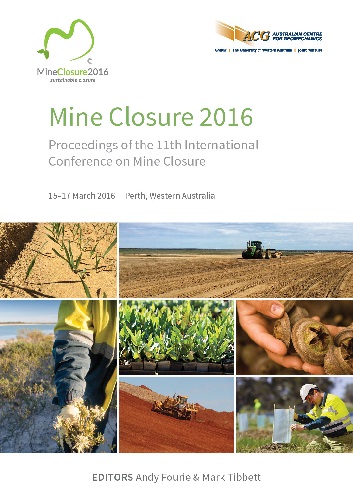Hydrological function of berms within a waste landform design

|
Authors: Roddy, B; Howard, E |
DOI https://doi.org/10.36487/ACG_rep/1608_01_Roddy
Cite As:
Roddy, B & Howard, E 2016, 'Hydrological function of berms within a waste landform design', in AB Fourie & M Tibbett (eds), Mine Closure 2016: Proceedings of the 11th International Conference on Mine Closure, Australian Centre for Geomechanics, Perth, pp. 63-74, https://doi.org/10.36487/ACG_rep/1608_01_Roddy
Abstract:
Berms remain a persistent feature in waste dump landform designs as they are perceived to provide the benefits of reduced slope length, protection against future batter erosion by partitioning the slope with level or backsloping berms, and reduced flow velocity. Underpinning this rationale is the belief that the berms will be a permanent and unchanging feature that controls erosion over the long term. These assumptions are not true. Berms begin to evolve immediately after their construction by trapping sediment and having a beneficial effect over the short to medium term. Longer term, berms fill with sediment and overtop. The time it takes to overtop depends on the material, the size of the berm, and the climate. Once a berm is breached, previously hydraulically disconnected batter sections become a connected flow network that delivers large volumes of runoff from upper slopes to lower slopes that were never designed to withstand them. This process can be caused, or contributed to, by poor quality construction techniques.
Keywords: landlform design, erosion, soils, berms
References:
Govers, G & Poesen, J 1988, ‘Assessment of the Interrill and Rill Contributions to Total Soil Loss from an Upland Field Plot’, Geomorphology, vol. 1, no. 4, pp. 343–354.
Howard, E & Lowe, S 2014, ‘Innovative Rehabilitation of Marine Dredge Spoil’, in Proceedings of the Ninth International Conference on Mine Closure, University of the Witwatersrand, Johannesburg.
Howard, EH & Roddy, BP 2012, ‘Evaluation of the Water Erosion Prediction Project (WEPP) model: validation data from sites in Western Australia’, in Fourie, AB & Tibbett, M (eds), Proceedings of the Seventh International Conference on Mine Closure, Australian Centre for Geomechanics, Brisbane, pp. 81–92.
Howard, EH, Shemeld, J & Loch, RJ 2010, ‘‘Ramelius Resources’ Wattle Dam Project: Achieving bond reduction through leading practice’, in Proceedings Goldfields Environmental Management Workshop, Goldfields Environmental Management Group, Kalgoorlie-Boulder, pp. 236–246.
Howard, EH, O’Kane, M, & Loch, R 2011a, ‘Emerging trends in the development of stable mine waste landforms and cover systems for reactive materials’, in LC Bell & B Braddock (eds), Proceedings of the Seventh Australian Workshop on Acid and Metalliferous Drainage, Goldfields Environmental Management Workshop, JKTech Pty Ltd.
Howard, EH, Loch, RJ & Vacher, CV 2011b, ‘Evolution of landform design concepts’, Mining Technology, vol. 120, no. 2, pp. 112–117.
Loch, RJ & Vacher, CA 2006, ‘Assessing and managing erosion risk for constructed landforms on minesites’, in Proceedings of the Goldfields Environmental Management Workshop 2006, Goldfields Environmental Management Group, Kalgoorlie-Boulder, pp. 121–127.
Loch, RJ & Willgoose, GR 2000, ‘Rehabilitated landforms: designing for stability’, in Proceedings of the 2000 Workshop on environmental management in arid and semi-arid areas, Goldfields Land Rehabilitation Group, Kalgoorlie-Boulder,
pp. 39–44.
Robinson, M, Howard, E & Berghofer, P 2014, ‘Case study: Using large-scale field plots to monitor erosion of waste dump batters at Birla Nifty Copper Operation’, in Proceedings Goldfields Environmental Management Workshop, Kalgoorlie-Boulder.
Stevens, T 2006, ‘The development of key performance indicators for progressive rehabilitation at the Murrin Murrin nickel/cobalt operation’, in Proceedings of the Goldfields Environmental Management Workshop, Goldfields Environmental Management Group, Kalgoorlie-Boulder, pp. 112–120.
Vacher, CA, Raine, SR & Loch, RJ 2004, ‘Tunnel erosion in waste rock dumps’, in Proceedings of the Goldfields Environmental Management Workshop, Goldfields Environmental Management Group, Kalgoorlie-Boulder, pp. 153–158.
© Copyright 2025, Australian Centre for Geomechanics (ACG), The University of Western Australia. All rights reserved.
View copyright/legal information
Please direct any queries or error reports to repository-acg@uwa.edu.au
View copyright/legal information
Please direct any queries or error reports to repository-acg@uwa.edu.au